Native Plants for Drought Tolerant City Landscaping
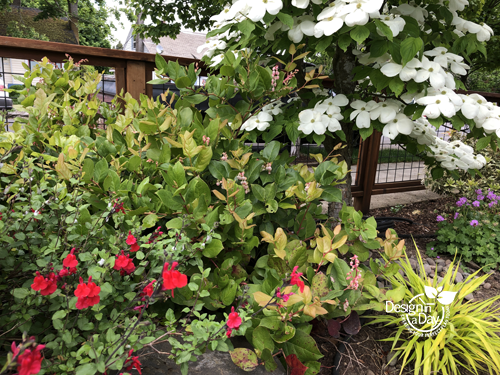
Drought tolerant landscape plantings in N. E. Portland Salal, Salvia and low water native dogwood tree ‘Venus’ add color to this small city front yard.
People dream of a landscape that will need no watering. Sometimes because they think it will be less work but more likely these days they recognize that water or the lack of it is an environmental problem that will continue to grow. Like the Brits in World War II we want to do our bit to help with a very real problem.
One way to have a no water landscape is to use NW native plants that are drought tolerant. Here are some tips to help you have more success growing NW Native plants for your drought tolerant landscape.
What size of plants to plant-size matters
Natives are a little more particular than other plants. Use 2 gallon sized plants not 4 inch or 1 gallon for best results with native plants like Salal-Gaultheria shallon, Ocean Spray-Holodiscus discolor, Huckleberry-Vaccinium ovatum, Current-Ribes sanguineum or the favorite native of all, Vine Maple-Acer circinatum. They will establish better if you start with a bigger root ball. Expect 20 percent of your plants to fail even when using a larger sized plant. I tend to plant an inch or two too high rather than too low with these plants or any that are drought tolerant.
Sword fern size can be smaller
If you are planting Sword fern Polystichum munitum, save your money and buy smaller plants, like a 1 gallon. The two gallon rule does not apply because Sword fern establishes its roots much more easily. Unlike other natives it also can thrive in less than ideal soil with good results. It’s the only NW native plant that doesn’t need careful soil preparation. I’ve transplanted it from my woods and had it play dead for over one full year. It came up the second year and was back to a three foot wide fern by the third year. Fascinating. This plant can be killed but one would have to work at it. It can tolerate summer water and will look more attractive with regular water when planted in a sunny area. In shady areas it has looked quite attractive without a drop of summer water by the third year.
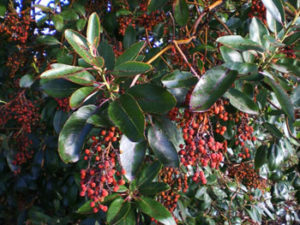
Pacific Madrone – Arbutus menziesii
has recently been approved for City of Portland street trees.
Madrone must be smaller
Madrone-Arbutus menziesii is perfect for a no water landscape and is very picky about how and where it is planted. This is because unlike most trees it has a tap root so it does not thrive in a pot for long. In the past I’ve only successfully planted a 6 inch tall plant. Recently friends of trees has found a way to grow them to about 5′ feet tall and plant them in parking strips. They are a needed plant for hosting rare butterflies so if this succeeds it will be very exciting. Two important tips for success with your new Madrone; water sparingly the first summer, and do not ever fertilize. After the first summer is over, never water your Madrone again. Don’t plant anything else within ten feet that needs summer water and don’t prune your Madrone. It’s a beauty that requires planned neglect for success. At this time I do not have a retail source for the larger Madrone. If you want one, buy the 6″ size at a native plant sale. They grow surprisingly fast. The size rule is also true for Manzanita because of tap roots.
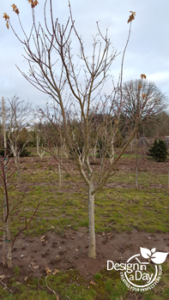
Vine maple with single trunk fits small city landscapes. Multiple stemmed trees will get too wide.
Vine Maple-Acer Circinatum
The most typical mistake I see in small city landscapes is multi stem vine maples horribly disfigured with poor pruning because they got too big. Most small city landscapes are not big enough for a multi stem or clump version of vine maple – Acer circinatum. Instead I select a single trunk vine maple from one of my wholesale growers. A single trunk tree will not get as wide. Single trunk trees are “made” by the grower so don’t expect to find them in the wild.
Plant NW native plants in the fall – Here’s why
Plant in fall for best results with native plants. Planting in late winter works almost as well but depends on how extreme the cold is. Planting in mid spring or summer will require more summer watering and some natives like California lilac, have an adverse reaction to summer water but their roots are not established well enough to go without water for the first summer so it’s a dilemma.
Avoid this dilemma when you can… by planting in the fall.
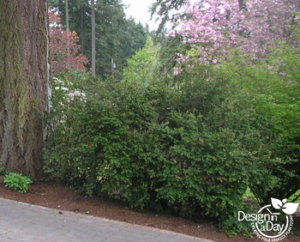
Evergreen Huckleberry used as a screen Hillside Neighborhood in SW Portland.
Evergreen Huckleberry comes in two sizes (sort of)
Evergreen Huckleberry-Vaccinium ovatum is almost like two different plants. Planted in a sunny area it grows slowly to 4’ tall and perhaps 3’ wide. While it will continue to grow and get a little bigger each year, it’s very slow growing. Compare it with the same plant in part shade to heavily dappled shade and it grows faster and is often in the 6 to 8 foot tall by as wide size.
People use the berries in muffins, pancakes and jam. I’ve always believed the flavor tends to be mild from plants in low elevations and more flavorful in higher elevations. Birds will eat them mild or tart but don’t tend to use them for baked goods. I have huckleberry at a very low elevation and at the end of a very very dry summer, I sampled some and they were very flavorful. I was surprised so now I’m questioning the old saying about high elevation berries.
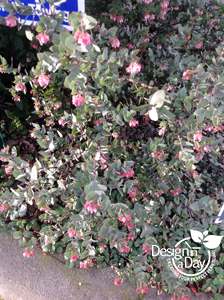
Manzanita-Arctostaphylos (maybe canescens subsp canescens) N W Portland street side plantings.
Soil Preparation
Most NW Native plants need well prepared soil. Some need fertile soil, some need a low fertility soil but almost all of them need well drained soil. I find most directions on how to prepare soil for NW natives quite complex. It is doable. If you are DIY, here is a web site that might be helpful. http://plantnative.org/how_siteprep.htm
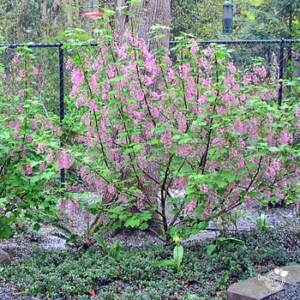
Flowering current – Ribes sanguineum is a spring pick me up for people and nectar for hummingbirds.
How to kill your plants
Plant too deep – Dig the hole several inches deeper than the root ball of the new plant. Or plant them in the lowest area of your property where they will be in standing water during the winter.
Here is a great way to kill your plants-Water them every day their first summer. They might live through the summer but will probably die over their first winter even if you only over watered them in the summer. This is probably not fair but if they did not go dormant properly due to overwatering or worse fertilizing… come May, you will be looking at brown woody stems with no buds or green leaves to be seen.
Best Practice-How to plant drought tolerant landscape plants.
Dig the hole twice as wide but only as deep as the root ball of the new plant. Plant 1” or 2″ high and bring soil or your mulch top dress up to the plants edges. Water carefully and thoughtfully the first summer. A slow long soak rather than daily light sprinkles of water is best. Mulch the plant in the fall and spring, don’t fertilize.
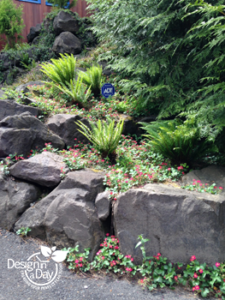
NW Native Sword fern – Polystichum munitum has upright fronds in sun and horizontal low fronds in shade.
Mix of NW Native Plants and Non Native Plants
As a Portland landscape designer, when I have clients who want no water landscapes, I tend to mix other plants with NW native plants. My list for a full sun area might look like this: Spanish lavender, dwarf manzanita groundcovers, oat grass, heather, California lilac, true dwarf pines, smoke tree, madrone, manzanita trees, grama grass, dwarf fountain grasses, rosemary, hebe, stepables groundcovers like ‘Elfin Pink’ thyme. Most of these plants will need irrigation initially and proper watering technique to develop a deep root system. Plants with deep root systems handle the heat beautifully. Ask us more about that when we work together to create your design.
Contact Us
If you are looking for drought tolerant landscaping for your Portland landscape, contact us. Let’s create a landscape design that balancing your needs for an attractive landscape for your home that includes native plants, and other low water plants that feed pollinators and provide color.




